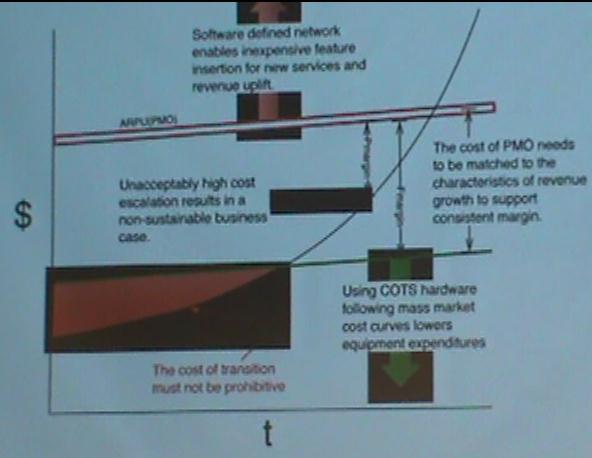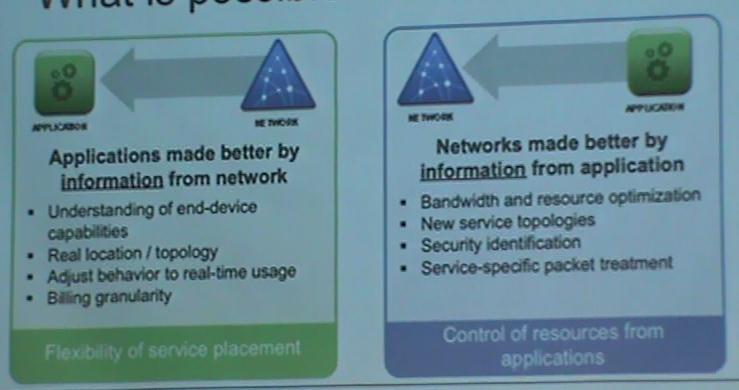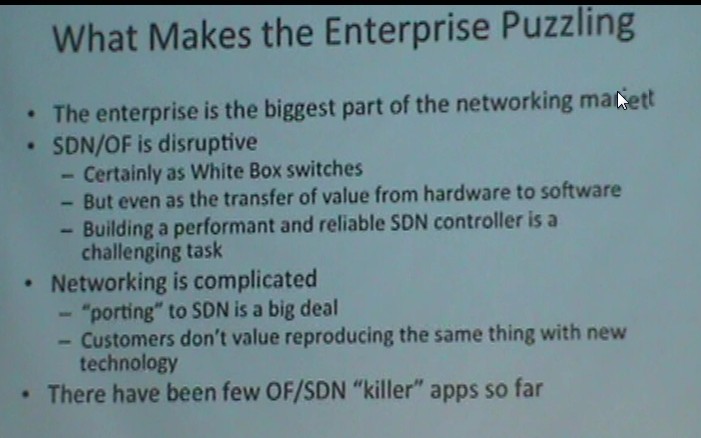Early this year, I wrote a post I called "What is all the hype about OpenFlow", and this really is the crux of the matter: is the excitement around Software Defined Networking (SDN) real, or is it being over-hyped. All significant technology movements must address real, serious problems. The main theme I took away from today is that OpenFlow and SDN are not simply great ideas to improve networking technology; these technologies address truly critical problems. Another important question is that, perhaps SDN is more than hype, but that doesn't necessarily mean it will have a lasting impact. There have been many 'almost' movements in the past based on sound principles, that have fizzled often do to political squabbling. But as I said in my day 2 recap, I am convinced that SDN is different and will fundamentally reshape the way that networking solutions are built and how networks are deployed and operated. The #1 reason: money. The single biggest thing that was said that really demonstrated why SDN will grow, and grow quickly was from Verizon's Chief technologist for Digital Media, Stuart Elby who presented the following slide (sorry for the poor picture quality):

如果你看一下图表的右上角,你会看到一条黑线与双红线相交。双红线代表Verizon的收入,而黑线代表的网络运营成本当前轨迹。正如你所看到的,与当前的发电技术,成本上升将非常迅速和显着超越,如果没有变化的收入。这使我的#2原因SDN将成为运营商级的现实很快:共识。SDN未必是应对这些挑战的唯一途径,但根据Elby,SDN是其中Verizon公司正在寻找解决这一难题:“我们看到,因为节约成本的巨大有理由继续前进,很快做到这一点,” Elby指出谁也指出,Verizon公司预计,远远超过从SDN,这同时将提供业务敏捷性大幅增加的增量成本节约。除了Verizon公司,快速看一下主持人在峰会上展示了高科技产业的领导者不只是参加名册,他们所倡导的,他们每个人似乎是围绕发展SDN的具体计划。SDN的前景似乎击中甜蜜点什么企业都在寻找,在灵活性和创新能力,在节省运营成本显著降低的显著增加,如果只有这个了人的因素,那么它可能有一个三连击..。进入的理由#3:人的因素。
What do I mean by this? I mean that in order for SDN to gain momentum, it must result in products being sold, and one must consider the people who influence the purchasing decision. In sales, the overriding philosophy is to try to make your sales pitch to the highest possible title in the company, but this doesn't quite work in the field of networking. Networking is quite complex, which has resulted in engineers having more influence on purchasing decisions than engineers do in many other domains of computing. The engineers who must support decisions to make changes in network products and processes don't have to pull the check out of their personal piggy bank. I am not saying these engineers don't care about saving their business money, they do; however one also has to consider when a new vendor tries to sell their product, that the engineer is the one left holding the bag. They are the ones that have to potentially relearn aspects of their job, they are the ones that get called in the middle of the night when something fails and they are the ones whose necks are on the line when outages occur. When visiting the product demos, I was able to provision a national-scale MPLS VPN network in about 4 mouse-clicks; it was then I saw firsthand that the human aspect of SDN was very real.
The summit was filled with technologists and engineers that were excited about SDN, and for technologists I don't think this excitement has to do with money, the excitement is found in the significant, meaningful advancement in technology that will make the lives of network engineers better and their jobs much more enjoyable. Google principle engineer Dr. Amin Vahdat really drove this point home, continuing a line of thought suggested by Dr. Scott Shenker suggesting that many engineers enjoy or find value in being masters of complexity. Vahdat posed that if network engineers like taking the risks necessary to operate networks today they must be 'adrenaline junkies', noting that common network operations often require downtime and can be quite risky. For example it is well established that a large percent of network outages are due to operator error. Dr. Vahdat presented the following slide (Note the last bullet point says "I introduce a product from a new vendor")

Vahdat说,最终压倒一切的理念实际上是,“如果我们不碰网络,也许它不会破”,其结果“在我的方式获取,而不是使计算和数据存储的网络”的。Vahdat指出,虽然服务器和存储递增经常更新,网络的升级路径是同步进行与基础设施的其余部分,他说,在“数以百万计的未充分利用的计算和存储系统的美元”的结果。他指出,该网络的典型升级路径是“分摊网络超过6〜8年,然后撕裂下来,并重新开始”。
Vahdat made another interesting point, which is that the complexity of the network leads to "fundamental under-investment in network". Now this sounds a little strange, I haven't run into many enterprises thinking 'gee, I'm just not spending enough on my network". But what I think Vahdat meant by this was that there are many network problems that applications try to solve through complicated and convoluted techniques in the application layer because they can't simply talk to the network. This point was really driven home by Juniper's David Ward, who gave several examples of multimedia applications that utilize various methods in the application layer to try to gain a derivative, poor understanding of the network. Ward presented the following slide:

So I don't think the point is that we need to spend more on the network, rather that application developers have to jump through a lot of hoops at the application layer rather than involving the network directly in the application development. To see some excellent applications of this concept, I recommend checking out some of the demos presented by Stanford's grad students from the conference which will be available这里.许多项目的演示了在峰会等也可以在OpenFlow的网站上发现这里.
因此,所有这些很酷的应用程序的声音很大,但他们何时会成为现实的企业呢?这给了产品演示两家北美最大的厂商分别是惠普和戴尔。我是戴尔的一名员工,我不是代言人戴尔,我应该注意到我没有产品组或营销工作,我没有任何接触路线图和战略,所以请注意,我在这里做是炒作的任何意见根据他们的介绍和演示。我想不带偏见,所以我已经包括戴尔和惠普介绍和演示视频可以随意得出自己的结论。这是令人兴奋的看到两个考虑在开发和推广SDN积极的作用,这些科技巨头,均作了精彩演讲。我觉得戴尔网络CTO庚霖的表现尤其显着,因为他提供了直接的洞察周围SDN戴尔的全面的产品战略。林博士的演讲指出,戴尔对数据中心,园区和分支办事处,这将充分利用OpenFlow的SDN和计划,但不包括产品细节。雷竞技电脑网站在试玩区提供了一些洞察到什么戴尔的应用程序的策略可能是围绕SDN的一部分。戴尔的SDN演示展示了他们的“高级基础设施管理器”编排平台API集成到从大交换网络一个OpenFlow控制器。 The demonstration showed the orchestration platform automatically provisioning local and remote or hybrid cloud overlay network topologies over an OpenFlow network using Force10 switches.
如果你一直在关注我的帖子SDN,你可能会认为它肯定闻起来很像葡萄酒和玫瑰;然而,由于在技术的任何动作,都将在路面颠簸,将需要冰释前嫌。互联网研究集团的分析师彼得·克里斯蒂发表了精彩演讲突出了许多非常现实的挑战和OpenFlow的SDN将面临获得市场采纳,我认为这提供了急需的角度会议。克里斯蒂提出了以下幻灯片:

After his presentation however, an audience member reflected on the critical problems that the network operators had shared throughout the day and posed a question to the entire panel of industry experts on stage: how else can we resolve the challenges described? I felt a bit of a stunned silence across the audience, and as optimistic as much of the audience was about SDN and OpenFlow, I felt this question provided something of an ah-ha moment. There were no answers offered. This did not lesson Christy's points in any way, he raised many of the same concerns I see among my enterprise customers every time I talk about SDN, which are basically that SDN is new, still needs to mature, and particularly for enterprise customers we still haven't seen many products hit the market (yet) that are addressing significant pain points.
一个领域,我认为克里斯蒂是正确怀疑是他对商业级的技术如何快速发展的关注。我的观察,虽然听着谷歌,Facebook和雅虎说话之后,是这些公司面临着从未见过的缩放挑战。今天,Facebook的例如有更多的流量比整个全球互联网仅仅几年前了。Facebook前副总裁乔纳森Heiliger注意的是,如Facebook面临着巨大的增长,他们只是试图保持网站的漂浮。但在这个过程中一些惊人的事情发生了,门户网站是不仅能够迎接挑战,他们提出的改进幅度订单,定义被重新定义的方式对整个世界消耗技术的新系统架构。克里斯蒂是正确的怀疑,我相信,没有技术制造商可能已经接近解决的缩放和该门户网站都面临着同样有效,因为他们能够开销的挑战。历史的智慧会说,如果你有一个性能或密度问题,请使用专门的硬件。但它是通过软件,在云架构的创新者能够超过在性能和规模的各项措施专门硬件的限制。现在,该行业在这个口头禅寻求建立,只有时间才能告诉我们技术的厂家将如何有效地能够为这些创新回应。
Another important point that Christy made was observing that standards bodies have become notoriously political, and have significant challenges themselves. And there is a lot of truth to this. In his series on innovation, Harvard professor Clayton Christenson observed that proprietary tech fills an important role when new and immature disruptive technologies are first launched. During this period new technologies experience rapid innovation which may be better served being unhampered by efforts to gain political consensus. While I can't disagree with Dr. Christensen on this point, what he described here is a problem not unlike any other problem that mankind has solved. And while there is still much to be proven, Open Networking Foundation (ONF) Director Dan Pitt gave an excellent presentation that demonstrated that the ONF put a lot of thought into how they designed and structured the organization to incorporate lessons learned from older standards bodies, software communities and from the devops and open source movements. He noted that the ONF's charter would not allow technology vendors to serve on the board of directors, but rather it should be governed by the network operators who have to live with the results. Working group chairs are assigned by the board, and a system of checks and balances has been put into place to try to prevent the problems that some standards organizations have become notorious for. This is not an end to problems, but I believe the structure of the ONF and the promise of SDN will help lead the posture of the industry into a new era that will be better at standardization, open interfaces and hopefully take steps away from vendor lock-in, towards more open innovation that will benefit the industry and the larger community.





